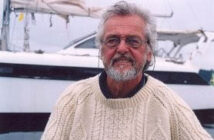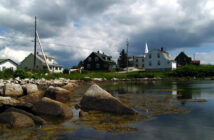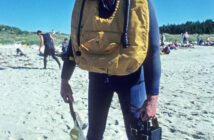Spiro Pappas attended schoool in 2nd High School of Patras, Greece, and studied at the University of Toronto, but now calls Nova Scotia his home.
Spiro’s ice dive in the video took place at Walton Gypsum Quarry (now decommissioned), in Walton, Nova Scotia. The Walton quarry, which worked from about 1810 to 1972, was one of Nova Scotia’s oldest significant gypsum operations. This mine like many other former mines and quarries is now a lovely lake. At the time of a 1913 government study discussing its construction, the quarry, also known as the South Mountain Quarry, had a working face that was about 100 feet tall and 400 feet long. The overburden (rock and soil on top of the gypsum deposit) was quickly extracted by hand in the quarry. Drilling was also performed by hand, and the rock was freed from the quarry’s face using “low strength dynamite.” The gypsum was then loaded into horse-drawn carts and transported to the Walton village shipping pier, where it was delivered to J. B. King’s New York factories.
Around 1913, the quarry’s annual production was approximately 25,000 tons. For 11 months out of the year, the quarry and pier hired 35 men on average to work the mine.
Former surface mines and quarries often become reservoirs when rainwater and water from underground springs naturally fill them. Most mines/quarries have water pumped out of them to prevent them from filling up, but when the operations are finished and the pumping ceases, the sites inevitably fill up. Walton Gypsum Quarry closed in 1972 and now is a dive site.
The bubbles in this video give it a special appearance.
Dive Report
The gypsum quarry changes the pH of the water and, since the quarry is spring-fed, the visibility can be excellent. It is usually 10-15 m.(4-6 ft) A flowering green plant is covering large parts of the bottom and hangs like a curtain in front of some of the steep walls. The walls are white gypsum with grey veins running through.
Freshwater- Maximum dive depth: 18m (59 feet)
Ice thickness: 28-30cm (1 foot approx)
Water temp: 0C- Air temp: -30C (-22F)
Weather: scattered clouds but mostly sunny
Visibility: 10m+ (32 feet)
Things to see: flowering plants covering many parts of walls/bottom, an old bucket, a relic from the old mining activity in the quarry.
Spiro Pappas
Video by CTV News
Dive Info from Spiro Pappas
Follow Spiro Dive’s Adventures on Facebook








